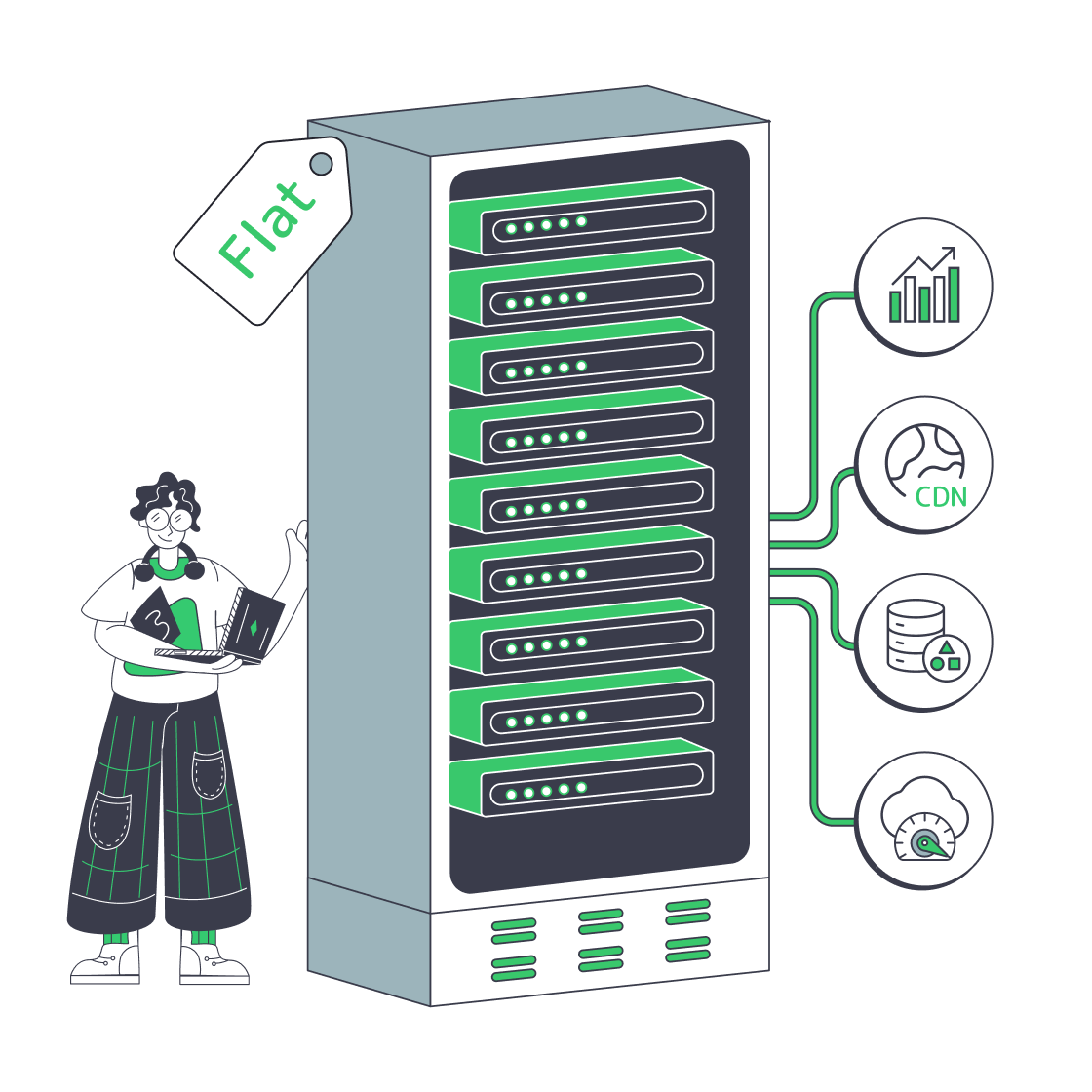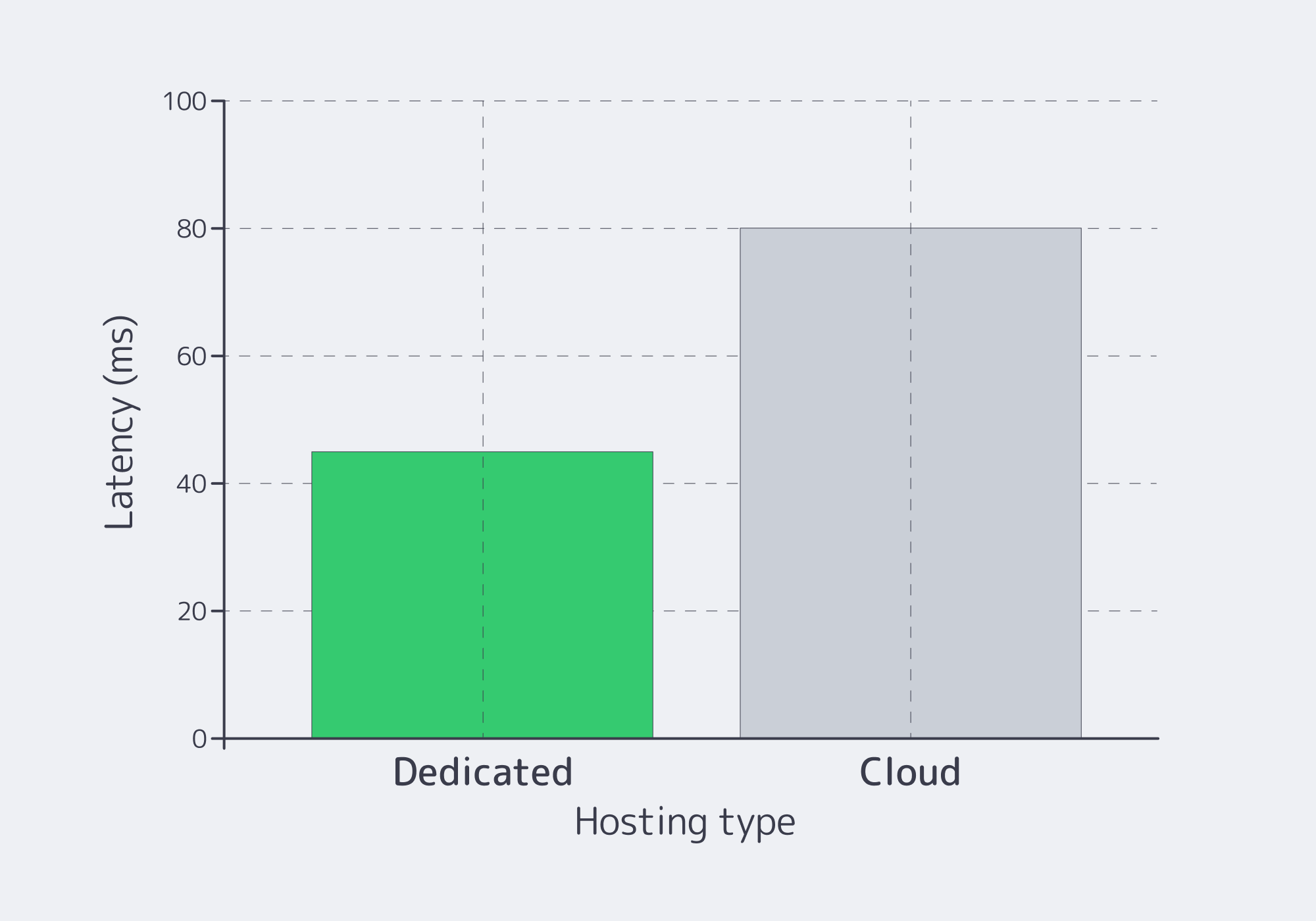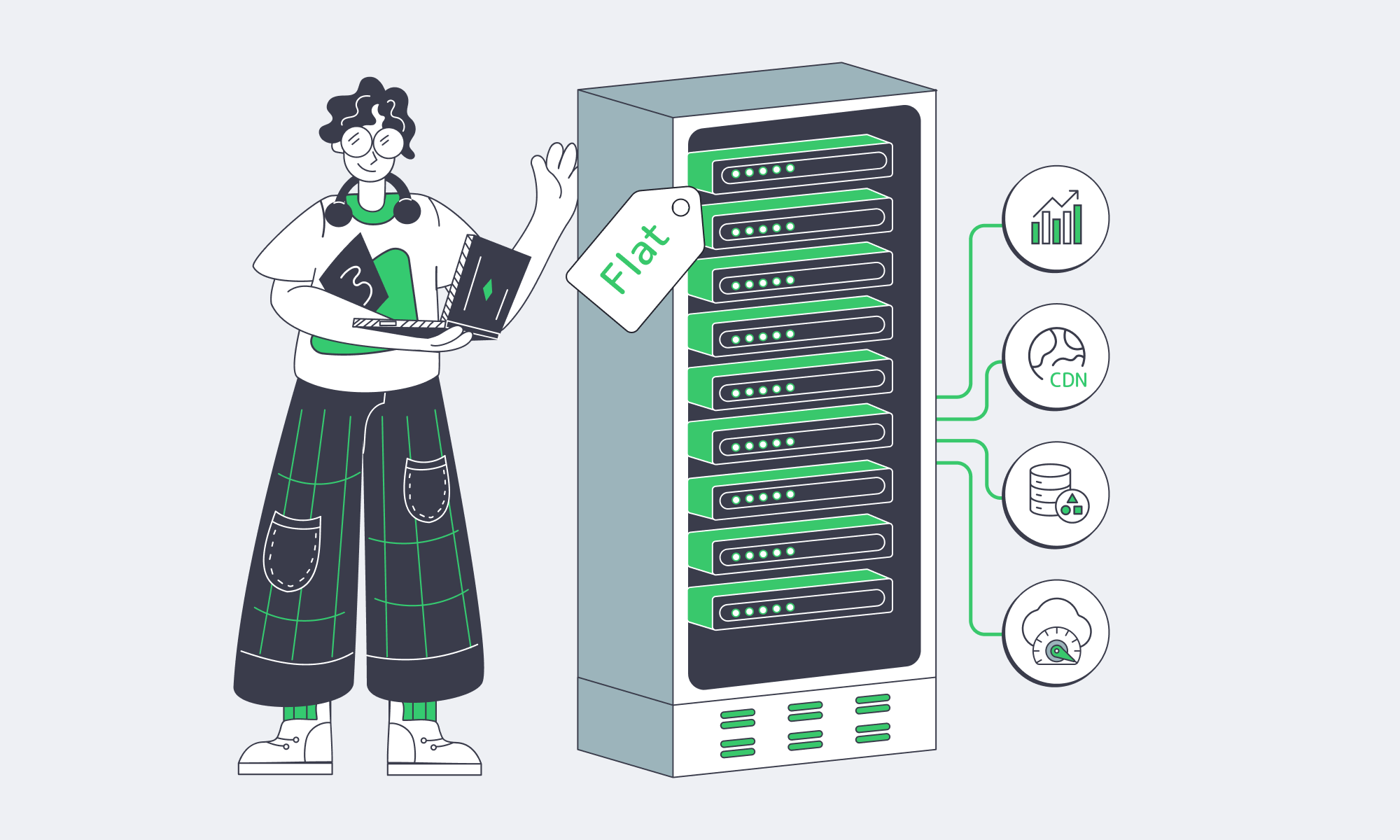Blog

Dedicated Servers: Slashing iGaming Hosting Costs
iGaming platforms run hot, late, and global, so the infrastructure choices you make are directly correlated with gross margin. The question is simple: where does the iGaming dedicated server model beat utility cloud on total cost of ownership without compromising performance and efficiency?
Choose Melbicom— 1,000+ ready-to-go servers — 20 global Tier IV & III data centers — 50+ PoP CDN across 6 continents |
 |
How Does Dedicated Server Hosting Lowers TCO for iGaming?
Usage-based cloud pricing scales every minute of uptime for the compute-heavy service (game logic, ledgers, trading/odds engines, compliance integrations), providing always-on services. You pay for instance hours, storage I/O, inter‑AZ and regional traffic, and—most agonizingly—egress. By comparison, a dedicated server contract charges a flat monthly OpEx for CPU, RAM, disks, and port capacity—your bill does not increase when sessions peak or streams run long.
The economics become more compelling as scale increases. Global online gambling revenue is already in the tens of billions, and with a double‑digit CAGR, steady backend utilization is the norm rather than the exception. Within that kind of environment, flat rate infrastructure is expected to win on TCO due to the marginal cost of an extra player minute being near zero until the point of capacity is reached. Current market estimates put online gambling revenue at approximately $78.7 billion, with sports betting as the largest sub‑segment—useful context for setting traffic and infrastructure requirements.
The second half of the equation is predictability. IDC indicates that almost half of cloud buyers spent more than planned in the previous year, and 59% expected to overspend again, noting that forecasting in pay‑per‑use environments is difficult even for mature teams; dedicated contracts avoid that forecasting problem.
A simple, illustrative iGaming server comparison for steady load
| 3 year host comparison Dedicated server Cloud instance | Dedicated server | Cloud instance |
|---|---|---|
| Monthly infrastructure charge | $250 (flat) | $400 (usage‑based) |
| Total cost – 1 year | $3,000 | $4,800 |
| Total cost – 3 years | $9,000 | $14,400 |
| Billing predictability | High (fixed) | Low (variable) |
Numbers are illustrative only; actual rates vary. The idea is to demonstrate the effect of a flat rate compounding to lower TCO in the case of continuous utilization.
Predictable Costs vs. Surprise Bills: How Flat‑Rate Pricing Restores Budget Control
Storage/egress and cross‑region bandwidth are typically associated with bill shock. Recent survey results show that 95 percent of organizations have been hit by unexpected cloud storage charges (egress, retrieval, API operations), underscoring how non‑compute line items can quietly sink budgets. And even as some of the providers have softened their egress at the point of leaving their platform on a permanent basis, multicloud or CDN egress costs are day to day.

These dynamics make cloud bills far more volatile from month to month than the monthly rental price of dedicated server hosting.
The impacts at the CIO level are not mythical: cloud overruns, project postponements, and forced reprioritizations have become the norm, according to industry reports. Dedicated hosting avoids that volatility; with a flat rate, you pay once for the capacity and can drive it to the limit. To offload traffic, install a CDN before your origins such that most of the bytes do not reach your server ports. CDN of Melbicom operates in 50+ PoPs in 36 countries and thus not only origin load is minimized but also allows bandwidth expenditure to remain linear on the core.
Headroom bandwidth is also important: Melbicom’s network provides per‑server ports of up to 200 Gbps at select sites, which are invaluable for live‑dealer video, jackpots with mass fan‑outs, and logs/telemetry replication, again on a predictable monthly payment rather than per‑GB surprises.
Maximizing Cost Efficiency without Compromising Performance
Hybrid scaling for peak events (baseline on dedicated, burst tactically)
The working solution is frequently that of both: implement the stable base load on dedicated machines and scale stateless front ends or microservices to the cloud on peak events. In that manner, you do not pay cloud premiums 24/7 and have elastic headroom in case of the Champions League final or to the Super Bowl. Industry analysis reveals that repatriation is not an all‑or‑nothing movement; in most cases, organizations end up with hybrid estates, with some workloads on dedicated servers and others on public cloud.
Executing this approach means placing origins in a few well‑peered metros for low‑latency paths to critical markets, fronting them with a global CDN, and exposing only the presentation tier to the internet. Melbicom has 20 Tier III/IV data centers and 1,000+ ready‑to‑go server configurations with 2-hour activation, so you can size the base just in time while still responding swiftly to forecast changes.
Automation reduces management overhead (without cloud mark‑ups)
Dedicated was once the word that meant manual. Not anymore. Using API driven provisioning, configuration management and IaC, you can treat physical servers just like any other pool:
- Provision via API into CI/CD flows, then join nodes to clusters automatically.
- Autoscale in coarse steps (add/remove physical nodes by policy) instead of fine‑grained VM steps—which is often simpler and cheaper in practice.
- Have observability SLOs (CPU saturation, tail latency, queue depth) to resource scheduling when on predictable cadences (weekly vs seasonal sports on live cadences), intra day vs predictable promos (live dealer promos).
Increasingly, FinOps programs are placing more focus on automation so that they can do more optimization with less human intervention- a practice that is easily ported to dedicated estates since the APIs and pipelines do not vary. Melbicom also has 24/7 technical assistance and managed support where you require hands-on assistance so your DevOps department does not turn into a hardware support desk.
Capacity planning: enough headroom, not waste
iGaming Capacity Planning should be fact based:
- Right‑size by region: peak concurrency follows time zones, so allocate capacity accordingly to avoid over‑building a single mega‑cluster and place cores close to major IXPs to minimize path variance; Melbicom’s presence in global metros keeps compute near players and payment rails.
- Incremental scale‑out: add mid‑sized servers as DAU grows over time rather than buying one piece of big iron, and use month‑to‑month dedicated contracts to flex seasonally without long commitments.
- Move bulk bytes to the CDN such that origin capacity is purchased on low-latency interactions and not on bulk delivery.
Performance isn’t a luxury; it’s the ROI multiplier
Single‑tenant servers eliminate noisy‑neighbor effects and hypervisor overhead. Practically, that provides smaller latency distributions, which is directly proportional to bet completion + session length.

So that, with fewer tail spikes, there is less abandoned carts, and fewer hedged bets because of jitter-value that you can put back to revenue.
Why is Cloud Repatriation Back on the Roadmap?
Modern repatriation is surgical: organizations pull back specific workloads from the cloud when unit economics no longer make sense (high, constant utilization, strict data‑residency requirements) and keep the rest where elasticity is valuable. Numerous studies converge on the same pattern: only about 8–9 percent of companies even consider full repatriation, yet a much larger share expects some movement to improve cost and latency control, often resulting in hybrid architectures. The headline driver is cost.
The economics can be seen in the wild: 37signals publicly projected $7 million in five‑year savings—without increasing the operations team—by moving a steady‑load SaaS off the public cloud to owned and dedicated capacity. It is not iGaming, but the trend (stable workload base → standardized prices base → reduced TCO-base) is similar.
iGaming Hosting Solutions Checklist
- Lock in a predictable base. Fixed price dedicated nodes with fixed size (60-75 percent peak) put durable workloads (accounts, RNG/odds, payments) on them.
- Burst only the edge. Use cloud autoscaling for API and presentation tiers during major events, then spin them down afterward.
- Engineer out egress. Serve as much traffic as possible from the CDN to minimize cross‑region chatter, and track and cap egress in SLOs.
- Automate capacity turns. Add/ remove dedicated nodes using IaC on schedules based on sports seasons and promotions.
- Buy bandwidth once. Prefer providers that have large per server ports to ensure replication and video do not come across per GB surprises.
- Measure ROI in user terms. Tie infrastructure changes to bet latency, session length, and hold rate; don’t optimize for instance count—optimize for margin.
- Keep options open. Hybrid is no trade-off but an allocation plan, which adheres to workload economics.
Where Does Melbicom Fit When You Make “Dedicated Server vs Cloud” Trade‑offs?
The iGaming dedicated server placement cannot be overlooked when your model requires flat rate predictability as well as performance. Melbicom operates Tier III/IV data centers in 20 locations with 1,000+ ready‑to‑go server configurations that can be online in less than 2 hours and offers bandwidth of up to 200 Gbps per server to accommodate unusual peaks. Install a CDN in 50+ PoPs to move heavy resources off the origin and retain origin capacity on low latency routes. The outcome: a floor that you can count on, and a worldwide competitive advantage that ensures gameplay and live streaming is responsive.
What’s the bottom line?

When your platform is continuously running and you want low variance in latency and cost, a flat‑rate dedicated model is usually the superior financial default. The cloud remains invaluable—particularly for experimentation and short bursts—but in practice egress, cross‑region traffic, and per‑unit compute pricing are pure pay‑as‑you‑go, which tends to over‑index on volatility. The case of TCO gets stronger with the increase in utilization and with the dependency of global delivery on smart CDN offload rather than the over provisioned origin fleets.
A forward‑looking plan doesn’t pick a single winner; it allocates workloads—dedicated for the stable spine, cloud for elasticity, CDN for bytes, and S3‑compatible object storage for media, logs, and backups, ideally with clear pricing and data residency. This combination maximizes ROI while keeping budget risk low, and you should evaluate providers on time‑to‑deploy, per‑server bandwidth, PoP coverage, and support depth rather than just GHz or core counts.
Build predictable iGaming infrastructure
Deploy dedicated servers with global CDN and 24/7 support to cut bill shock and keep latency low across peak events.